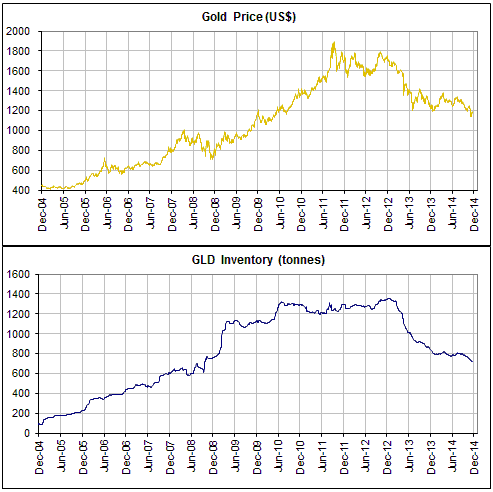Why GLD’s bullion inventory follows the gold price
Posted By Steven Saville On November 18, 2014 @ 1:06 am In Uncategorized | Comments Disabled
The concept that must always be kept in mind when analysing changes in the amount of gold bullion held by the SPDR Gold Trust (GLD), the largest gold bullion ETF, is that these changes can only happen as a result of arbitrage. More specifically, the Authorised Participants (APs) in the ETF will only add gold to the inventory when an arbitrage opportunity is created by the price of a GLD share moving above the net asset value (NAV) of a GLD share and remove gold from the inventory when an arbitrage opportunity is created by the price of a GLD share moving below the NAV of a GLD share.
The addition of the gold involves multiple steps (the short-selling of GLD shares, the purchase of gold bullion, the delivering of gold bullion to the ETF and the creation of new GLD shares that are used to cover the aforementioned short position) that occur almost simultaneously, but the key is that it is a mechanistic process that a) gets initiated by GLD’s market price moving above its NAV and b) serves the purpose of closing the price-NAV gap. Similarly, there are multiple virtually-simultaneous steps involved in the removal of gold from GLD’s inventory (the buying of GLD shares, the short-selling of gold bullion, the redeeming of GLD shares for gold bullion from GLD’s inventory, and the use of the bullion obtained from the inventory to cover the aforementioned gold short position). And again, it is a mechanistic process that a) gets initiated by GLD’s market price moving below its NAV and b) serves the purpose of closing the price-NAV gap.
In the hope of adding clarity I’ll mention two related points.
First, it is not possible for GLD’s gold inventory to be used to cover short positions elsewhere in the gold market except as part of the arbitrage described above.
Second, because GLD holds gold bullion, a change in the price of gold will not necessitate a change in GLD’s inventory. GLD’s shares will naturally track the price of gold without the need to do anything, regardless of how far or how fast the price of gold moves.
That being said, there are times when the buyers of GLD shares become over-eager, causing the market price of GLD to rise relative to the price of gold, and there are times when the sellers of GLD shares become over-eager, causing the market price of GLD to fall relative to the price of gold. This sets in motion the arbitrage described above.
Now, buyers are most likely to become over-eager after the price has been trending higher for a while and sellers are most likely to become over-eager after the price has been trending lower for a while. That’s why the chart presented below shows that major trends in the GLD inventory FOLLOW major trends in the gold price, and why it makes more sense to view 2013′s large decline in GLD’s gold inventory as an effect, not a cause, of the large decline in the gold price.
Article printed from TSI Blog: https://tsi-blog.com
Click here to print.
